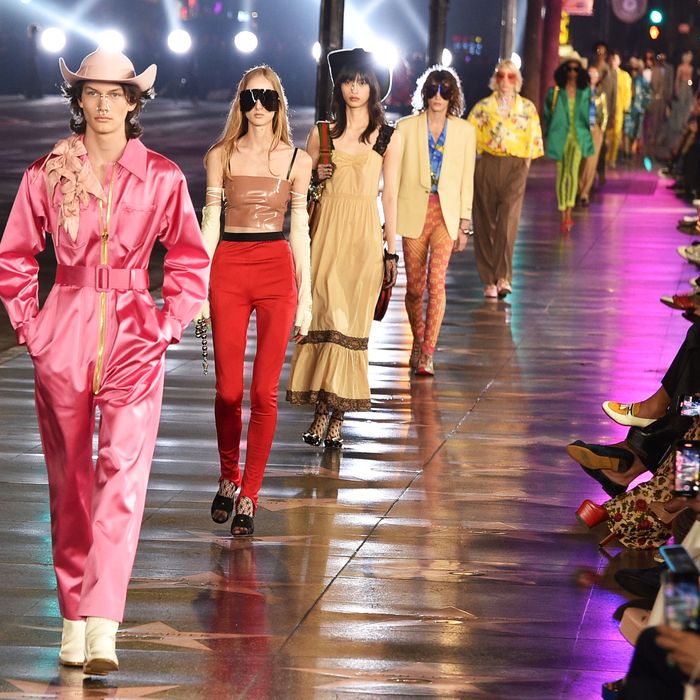
Before the start of Gucci’s Love Parade on Hollywood Boulevard last night, and before the stars took their seats in director’s chairs on the sidewalk, I walked the length of the well-washed block, from one bank of klieg lights to the next. I wanted to understand not only the scale of the famous strip, home to such landmarks as the Chinese and El Capitan Theaters and the Walk of Fame, but also the possible reasons Alessandro Michele had for choosing it as the backdrop for his spring 2022 collection.
Was it the knife-edge balance between nostalgia and misery? The former Grauman’s Chinese Theater holds red-carpet premieres, and the elegant Roosevelt Hotel is nearby, but so are the tents of homeless citizens. (Gucci, perhaps to head off a potential PR fiasco, announced it would give $1 million in grants in “the areas of homelessness, mental health, and youth culture.”) Was it the bright, manufactured side of glamour and the tacky, all-too-real flip side that intrigued Michele, who once hosted a cocktail party in the Hollywood Forever cemetery? On Tuesday night, the vast majority of stars — Diana Keaton, Lizzo, Billie Eilish, Serena Williams, Angelica Huston, Gwyneth Paltrow, to mention a few — were seated smack-dab against the storefronts on one side of the street, while other guests were seated on the opposite sidewalk. In between were four lanes of empty pavement that had a diminishing effect on everyone. Once the show began, I had an urge to whip out my opera glasses to see Gwyneth’s classic red-velvet Gucci pantsuit, but, alas, I left them at home with my long gloves and tiara.
Considering that Michele’s clothes played to all the beautiful-and-the-damned contrasts, it’s fair to assume he chose Hollywood Boulevard for the same reason. Life is both sensations, he said during a post-show press conference. He also noted that Gucci has its roots not in the European aristocracy or bourgeois society, as most fashion houses in Paris and Rome do, but rather in the jet set, cinema, and American consumers. Long before Armani conquered Hollywood with his soft-tailored power suits, Gucci’s snaffle-bit loafers and taupe logo bags were the thing. And, of course, Tom Ford, who designed the Paltrow suit, in 1996, brought his own cinematic verve and achy-achy longing to Gucci.
Indeed, I felt the Ford years in this collection at times, specifically a look that featured beige-pink satin bra cups on the front of a black coat (it fondly brought to mind a Ford show from the early 2000s that I loathed) and perhaps satin suiting with boxed-shoulder jackets. For his part, Michele kept shifting the aesthetic from polished glamour to hustler glamour (conveyed with cowboy hats and three-piece satin suits, minus a shirt) to washed-up glamour (a rather lovely and sad gold lace gown with a droopy red-velvet hem and a white fake-fur fling.) The cast also had a world-weary quality, and included the singer St. Vincent, in a dramatic black cape and weird cat’s-eye glasses; the artist Miranda July, in foxy garters and a cheerful, fruit-adorned sweater; and the former child star Macaulay Culkin, whose outfit — souvenir-print shirt, light-colored trousers with a tan GG belt, windbreaker — seemed almost intentionally drained of glamour.
Though the scale of the boulevard overwhelmed the clothes, and though the models were oddly inexpressive, almost sad-looking — in contrast to Demna Gvasalia’s comic red-carpet show or Balenciaga in October — I feel certain the brand’s digital genies will nonetheless create a wonderful marketing video. Which is the point of the whole exercise. There were some terrific elements in the show, notably the many pantsuits, a few of the splashy siren gowns, the patterned stockings, and the cowboy hats, which I predict will supplant Gucci caps. But to search for a fresh slant, an innovative cut or detail is to search in vain. The brand is the message.
And the thing is, it could have been a lot less reductive in its thinking. That’s what Gvasalia demonstrated with his clever red-carpet show and collaboration with the creators of The Simpsons. He also proved it with his couture show in July, which sent couture into a new stratosphere. You can be far more considered about a collection and its intersection with culture (or not), and still tick the branding boxes.
How much more electrifying would Gucci’s Love Parade (an echo of the MGM Parade series of the mid-’50s) have been had Michele skipped the clichéd backdrop and instead, say, staged his version of a Hollywood musical? That would have been fun and so much more generous in spirit.







